
Christmas Holidays at Sea: 1 2 3 4 5 6 Next>>
Christmas Holidays at Sea in the Golden Age of Piracy, Page 4
Buccaneers and Christmas Abroad
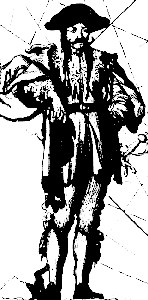
Artist: Joan van Keulen
Buccaneer from
Map -
Pas kaart Van
de
Noord
Kust van Espaniola (1684)
Several of the Buccaneer's accounts from their sea-going adventures give us details on how they celebrated Christmas at sea and abroad. Nearly all of them involve Captains Sharp, Sawkins, and Coxon on their raids in South America and the Caribbean which began shortly after Christmas in 1679.1 The primary element of the Christmas celebration among the buccaneers is just what Labat intimated: alcohol.
William Dampier explains that "Ships coming from some of the Caribbe Islands, are always well stored with Rum, Sugar, and Lime-juice to make Punch, to hearten their Men when they are at work, getting and bringing aboard the Salt ; and they commonly provide the more, in hopes to meet with Privateers, who resort hither in the aforesaid Months, purposely to keep a Christmas, as they call it; being sure to meet with Liquor enough to be merry with, and are very liberal to those that treat them."2
The first of Sharp's buccaneering crew's Christmases at sea (1680) found them at Juan Fernandez Island (today called Alejandro Selkirk Island). The account originally written by Ringrose is found in Alexandre Exquemelin's book explains that "being Christmas-day, we gave in the morning early three Vollies of shot, for solemnization of that great Festival."3 (Note that Ringrose's original book does not mention this detail. Several additions were made to Ringrose's book when it was appended to Exquemelin's book and it is not clear who made them. Glyndwr Williams suggests it may have been Ringrose, editor William Hack or perhaps even Sharp.4 If it was Hack, the differences should rightfully be questioned.) Captain Bartholomew Sharp relates in his journal that the crew found the island "a very refreshing Place to us both in respect to the Goats we found here... [as well as] fresh Water wherewith we filled our Vessels."5 A few days later he reports that on the eastern side of the island the crew "met with great store of Fish, and particularly Lobsters, in this Place as also three Springs of good Water."6
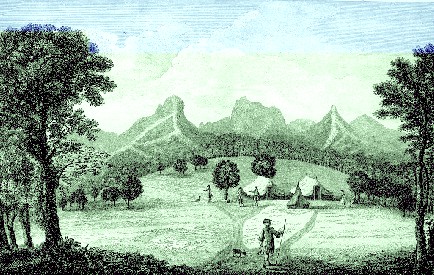
Encamped on Juan Fernandez Island, from Voyage Round the World
by Geroge Anson (1748)
This particular Christmas did come with one problematic detail about their time on Juan Fernandez Island in 1680: the seals. "Here we saw multitudes of seals, covering the bay every where, insomuch that we were forced to kill them before we could set foot on shore."7 Nothing says 'Happy Holidays!' quite like clubbing seals! (This detail is also not found in Ringrose's original book.)
Of course that paled in comparison with Captain Sharp's other problem during the the Christmas break spent on Juan Fernandez. Some of the men had turned mutinous. Basil Ringrose notes in his journal that "it is usuall amongst the generality of men, that plenty of all things [as they found on Juan Fernandez Island], breeds an increase of ill humors, Faction and Disturbances."8 The surgeon might have been able to draw off the bad humors through judicious bleeding, but faction and disturbances had to be cured in another way. Some of the men wanted to return to England while others wanted to stay on the West side of the Americas to take more Spanish ships and cities.
So the discontent members of the crew mutinied. Basil Ringrose explains the Christmas crises in his book.

Artist: George Roux
Not a Christmas Present You Expect
"Squire Trelawny firing at the Pirates"
from Treasure Island (1885)
A party of the disaffected to Captain Sharp got ashoar and subscribed a Paper to make John Watling Commander, pretending liberty to a free election as they termed it, and that Watling had it by vote. The reason of this mutiny was that Sharp had got about 3000 pieces of Eight, and was willing to come home that year, but two thirds of the Company had none left; having lost it at play [gambling]; And those would have Captain Sharp turned out, because they had no mind as yet to return home. This Fewd was carried on so fiercely, that it was very near coming to a civil War, had not some prudent men a little moderated the thing...9
However, Watling was killed in battle not long after and Sharp was reinstated as ship's captain.
This did not really solve the problem of the mutinous members of the crew, who seemed to find Christmas a good time to sow dischord. The version of Ringrose found in Exquemelin, explained that on December 7th of the next year, "our worthy commander, Captain Sharp, had very certain intelligence given him, that on Christmas-day, which was, now at hand, the company, or at least a great part thereof, had a design to shoot him; he having appointed that day some time since to be merry.10 (This information does not appear in Ringrose's original book.)

The British Sailors Loyal Toast, from The British Tar in Fact and Fiction, p. 136 (1738)
Ringrose placated them with wine at that time, but the topic recurred during their several week stay on Juan Fernandez over the Christmas holiday. Captain Sharp described it thus: "When to Solemnize that Festival as well as we could, we eat the only Hog we had left, drank some Jars of Wine, and made our selves as merry as we were able, which I did that my Men might not mutiny."11 Fortunately for him, a second mutiny did not come to pass.
Of this Christmas feast, Exquemelin's version of Ringrose says that Captain Sharp "made us share the wine amongst us, as being persuaded they would scarce attempt any such thing [as mutiny] in their sobriety. The wine we shared fell out to three jars to each mess."12 Pretty sharp of Sharp to use his wine so strategically. This highlights the importance of celebrating the holiday properly vis-a-vis the morale of the buccaneers.
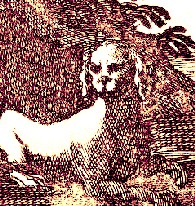
Sorry Phydeux! You're what's for
dinner! From On the Spanish Main
by John Masefield (image: 1744)
There are some minor differences concerning the menu between
the various accounts of this Christmas dinner. The version of Ringrose found in Exquemelin provides a lot of detail, explaining that the crew "killed yesterday, in the evening, a sow. This sow we had brought from the Gulf of Nicoya [where they had been in early April of that year, near what is now Isla Caballo, Costa Rica], being then a suckling pig, of about three weeks old, but now weighed about fourscore and ten pounds. With this hogs-flesh we made our Christmas-dinner, being the only flesh we had eaten since we turned away our prizes under the Æquinoctial, and left the Island of Plata [Isla de la Plata, Ecuador]."13 Ringrose's actual account calls the sow "a large Hogg"14. He also expands upon the menu, explaining that "we killed it [the hog] for Dinner, but thinking it not enough for us all, we bought a Spaniel-Dogg of the Quarter-Master for forty pieces of Eight, and killed him; so with the Hogg and the Dogg, we made a Feast, and we had some Wine left, which made us merry"15. So... dog for Christmas dinner! Enjoy the holiday, everyone!
1 William Dampier, Memoirs of a Buccaneer, Dampier’s New Voyage Round the World -1697-, p. 28; 2 Dampier, p. 85; 3 Alexandre Exquemelin, Bucaniers of America, Part IV, 1684, p. 116; 4 Glyndwr Williams, The Great South Sea: English Voyages and Encounters, 1570-1750, 1997, p. 92; 5 Bartholomew Sharp, "Captain Sharp's Journal of His Expedition," from William Hacke's A collection of original voyages, p. 44; 6 Sharp, p. 45; 7 Exquemelin, Bucainers, Part IV, p. 116; 8 Basil Ringrose, The voyages and adventures of Capt. Barth. Sharp and others, in the South Sea, p. 48; 9 Ringrose, p. 49; 10 Exquemelin, Bucainers, Part IV, p. 198; 12 Sharp, p. 54; 13 Exquemelin, Bucainers, Part IV, p. 202; 14 Ringrose, p. 108; 15 Ringrose, p. 108-9
Christmas with the Pirates
"After this Cruize, they [Jack Rackham's crew] went into a small Island and cleaned, and spent their Christmas ashore, drinking and carousing as long as they had any Liquor left, and then went to Sea again for more, where they succeeded but too well, though they took no extraordinary Prize, for above two Months..." (Captain Charles Johnson, The General History of the Most Notorious Pirates, 3rd Edition, p. 151)

William Dampier, from
The Coming of the British to
Australia 1788 to 1829
by Ida Lee (1906)
From the few accounts we have, the pirates celebrated Christmas with the best of them, generally feasting when they could and resorting to their old favorite standby: liquor.
William Dampier gives us a couple of accounts of Christmases spent sailing with Captain Charles Swan. (Dampier and Swan walked the line between buccaneer and pirate throughout their careers. While it could be successfully argued that they were still buccaneers at this point, I have decided to stick them in with the pirates.) In 1685, Dampier reveals that they "sent in 2 Canoas [canoes] with the Strikers [Moskito Native harpooners] to get Fish, being desirous to have a Christmas Dinner. In the Afternoon they returned aboard with 3 great Jew-fish [Atlantic Goliath grouper], which feasted us all; and the next day we sent ashore our Canoas again, and got 3 or 4 more."1
The next Christmas found the crew at Mindanao - the last island of the Philippines. While there, Captain Swan "desired all his Men to be aboard that Day [Christmas], that we might keep it solemnly together: And accordingly he sent aboard a Buffaloe the Day before, that we might have a good dinner."2 Swan ate on the ship with his men and then went back to shore. His men mutinied and took his ship Cygnet later.
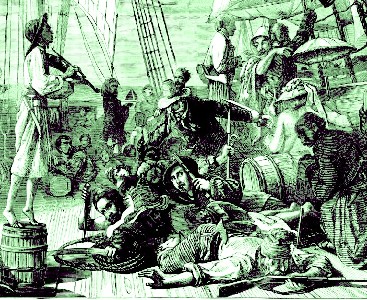
Artist: M. Baird
Pirates (a political cartoon, but it works) Harpers Weekly (July, 1861)
In 1720, pirate Captain Edward England's crew spent Christmas " in Carowzing and Forgetfulness, and kept it for three Days in a wanton and riotous Way"3. Of course Johnson immediately added a caveat to this story (as he was wont to do) noting that in doing so, they wasted "their fresh Provisions in so wretched and inconsiderable a Manner, that when they had agreed after this to proceed to Mauritius [an island off the eastern coast of Madagascar] they were in that Passage at an Allowance of a Bottle of Water per Diem, and not above two Pounds of Beef, and a small Quantity of Rice, for ten Men for a Day, so that had it not been for the leaky Ship, (which once they were about to have quitted, and had done, but for a Quantity of Arrack [cheap wine] and Sugar She had on Board,) they must most of them have perished."4Johnson several times makes the point that many of the pirates were not very good at planning the use of their victuals. But... Christmas!

Artist: John Taylor
Drunken Celebrants, From A Brown Dozen of Drunkards (1648)
According to an account by captured and forced master's mate Richard Lazenby, pirate captains John (Richard) Taylor and Jaspar Seagar celebrated Christmas in a similar manner in 1720. Lazenby reports that "they caroused, and kept their Christmas in a most riotous manner, destroying most of the fresh provisions they had aboard, of which quite two-thirds was wasted. After three days of such debauchery and waste, they decided to go to Mauritius to repair the Victory, which was now in a very bad way."5
Christmas is typically a time for family, but when you're a pirate living overseas in a desolate place like Madagascar, who is your family? Other pirates, of course. John Bowen's pirate crew learned that Thomas Howard had taken an East India merchant ship named Prosperous and sailed the prize to the pirate hangout at New Mathelage (Majaranga, Madagascar), eventually anchoring her on the island of Mayotte. Hearing of their brother pirates' success and being "too weak of themselves to undertake any considerable Enterprize… they sailed to Mayotta, where they found her lying at Anchor; this was about Christmas 1702. Here these two Powers struck up an Alliance, Howard liking the Proposals, came readily into it, and the Treaty was ratified by both Companies."6 Hey, if you can't celebrate with family, you may as well join and celebrate with your murderous extended family!
Of course, some people have to work on Christmas and this included pirates. Around Christmas of 1723, Edward Low's pirates "took a Ship of 12 Guns on the Coast of Guiney, called the Delight, (formerly the Squirrel Man of War) commanded by Captain Hunt."7
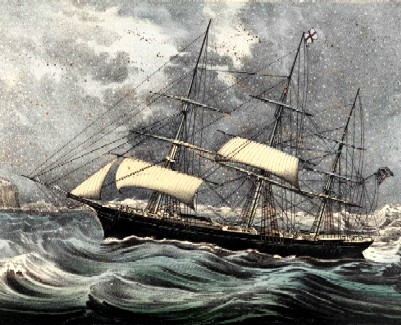
A Clipper Sailing in a Snow Squall, Currier & Ives (1860)
Piracy is a busy profession and not every pirate can just kick back and celebrate such holidays, so one of Low's men, Francis Spriggs, "took Possession of the Ship with eighteen Men, left Low in the Night, and came to the West-Indies."8 Piracy! The gift that just keeps on giving. (Or, in this case, taking.)
And what is Christmas without snow? (Actually, it's pretty typical for the Caribbean.) We do have one buccaneer/pirate account of a snowy Christmas... sort of. It is from buccaneer surgeon Lionel Wafer's account of sailing with our old friend Captain Sharp. Wafer relates that "Upon Christmas day, 1687. we were just clear of the Storm, and in the Latitude we mentioned, off Cape Horn. Running hence to the Northward again, being now got out of the South Sea, we met several Islands of Ice; which islands of at first seemed to be real Land."9 While he doesn't actually talk about snow, he does note that "[f]rom these Hills of Ice came very cold Blasts of Wind; insomuch that our Men, newly coming out of a hot Country, could hardly endure the Deck."10 So as cheerful as many of us think of snow at Christmas, it may be best not to wish for snow at Christmas while at sea.
1 William Dampier, Memoirs of a Buccaneer, Dampier’s New Voyage Round the World -1697-, p. 273; 2 Dampier, p. 367; 3 Captain Charles Johnson, The General History of the Most Notorious Pirates, p. 133; 4 Captain Charles Johnson, p. 133-4; 5 Ed Fox, “56. Richard Lazenby, a prisoner of John Taylor, from The Narrative of Richard Lazenby", Pirates in Their Own Words, 2014, p. 284; 6 Daniel Defoe (Captain Charles Johnson), A General History of the Pyrates, Manuel Schonhorn, ed., 1999, p. 459-60; 7,8 Defoe (Captain Charles Johnson), p. 352; 9,10 Lionel Wafer, A New Voyage and Description of the Isthmus of America, p. 192-3; 6 Wafer, p. 193

